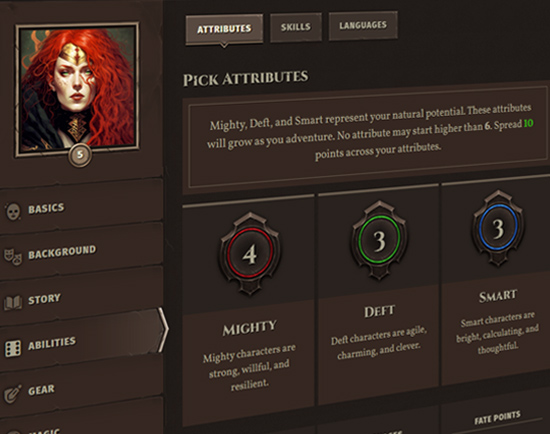NPC shorthand is a way to write out the stats for NPCs so it's easy to understand what an NPC can do in an encounter at a glance. Below are a few examples.
Example NPC Cards
Below are several examples of creating NPCs in the shorthand notation. When you create NPCs in OSR+, this format will make it easier to condense their stats to fit on an index card for easy reference while you run the game.
Redmainer Hunter
Human Ranger (L: 1 Monster Hunter)
M: 4, D: 4, S: 3
HP: 5/10, DEF: +6, MP: 8
(Shell Armor, Body Shield)
(Stealth : Attack)
“Friend of Beasts”
Skills: Survival +6, W: Edged +6
- Create Monster Hunting Supply (2 MP)
- Always Has Cheap Supply
- Wilderness Tracking/Stealth (A)
- Longsword +6: 5 (Defender)
Time Mage
High Person Mage (L: 5 Chronomancer)
M: 1 (D), D: 3, S: 8 (A)
HP: 4/6, DEF: +6, MP: 14
(Dimensional Robes)
(Spell || Maleficence)
Skills: Domain: Statecraft +10 (A), Influence +10 (D), Lore +5, Perception +5, Sorcery +10 (A)
- Acts on Any Turn (Chronomancer)
- Counterspell (Mage)
- Duo-Dimension (via Dimensional Robes)
- Bonus Parry (Energy Scepter)
- Maleficence +10 (A): d6 (Chaos)
- Energy Scepter +10 (A): 0 (Fire, Deflect)
Spells +10: Antimagic Whip, Chain Maleficence, Elemental Form, Fly, Haste & Slow, Heal, Spell Turning
Dissecting the NPC Card
The goal of NPC shorthand is to make it so that you don't have to look anything up when you're running an NPC. If you have the GM Cheat Sheet handy, the definition of tactics, maleficence (and their basic perils and their secondary effects) are readily available, so references to Reach or Lightning should be easy enough to look for on the cheat sheet.
Here's how it all breaks down line-by-line:
Name, Level, Origin, Class, Kit
For monsters, we just need to know their monster type (Humanoid) and their level. Monster types impart additional abilities that all monsters of the type share. For non-monstrous NPCs, we need to know their level, plus their origin, class, and kit.
Attributes
Mighty, Deft, and Smart. We write (A) or (D) if an attribute has advantage or disadvantage.
HP/AP, Defense, MP, and SOak
HP and AP are written as a pair: 5/10 means 5 HP and 10 AP, and defense is the bonus added to a d6 roll. Soak (not depicted above) is a flat number between 1 - 3.
Armor Type, Shields
This is an optional line to detail the sort of armor they're wearing and if they carry a shield. It's also a reminder of how to illustrate the NPC's armament in the fiction.
SKills
We list all known skills and their modifiers here. Exploding skills (not depicted above) are designated with an asterisk (*).
Abilities
The bulleted list encompasses anything the NPC can do that is not an attack, including passive abilities they may have (Immune to Fire) or abilities from kits and classes. This also includes the legendary actions that BBEGs may have.
NPC TAg
If it’s possible for the NPC to join the party, we add the NPC’s tag under its strategy notation in quotes and italics. The Redmainer Hunter for example has Friend of Beasts as its NPC tag.
Attacks/Maleficence
Each unique attack is underlined, so it sticks out visually. The pattern is Weapon Name [To Hit]: Damage (Tactics, Perils). Write down the style of weapon as opposed to its class, e.g., "Spear" vs. "Reach" so that you can remember what sort of specific weapon the NPC is carrying for narrative purposes, but avoid ambiguity ("Thrown Dagger" vs. "Dagger" distinguishes between a Thrown vs. Small weapon).
Spells
Finally, for spellcasters, list all their spells. If they have a mix of spells of different types of magic, you'll want to calculate their modifiers for each spell so you don't need to look them up. Boldface spells that the NPC comes into play with that (meaning they are already cast).
What About Stances?
Generally, stances are player-facing abilities and not meant to be adopted by monsters or other NPCs, but you can use stances as inspiration for the custom abilities monsters might have. In the section on encounter composition, you'll also learn that it's sometimes helpful to round out the party's competition by giving specials, bosses, and BBEGs stances.
Writing for Brevity
We want to make sure that everything on the card helps you be as lazy as possible at game time:
- The numbers are all pre-calculated by you when you write up the card, that way you don't have to do any math on the fly: just roll and add the bonus indicated. For example, we decided that the Yum Yum Goblin is skilled at spears, so we wrote down +3 to his attack (his Mighty of 1, +2 for being skilled with the weapon). He's not skilled at throwing Firebombs or using the Sling, so the +3 here reflects his Deft alone. The only thing you'll add is his mob bonus—a special ability that gives him a +1 to hit for each other Yum-Yum Goblin in play. Similarly, perks from level advancement are already factored into the final numbers.
- We're also careful to list abilities in a definitional fashion: with the Redmainer Hunter, instead of Resourceful (which is the class ability that the Ranger has), we write Always Has Cheap Supply because that explains what the ability does.
Strategy Notation
Strategy notation borrows syntax from programming (the conditional operator) to minimize the amount of language necessary to describe the NPC's behavioral pattern. A colon : means "then," whereas a double-pound || means "or." Finally the ? means "if." This is to remind you what the NPC would do if threatened, or any special things it might do as its status changes.
Some examples:
- Bloodied ? Earthquake : Club x2. If at half health, the giant uses its legendary Earthquake ability, otherwise it just attacks twice with a club.
- Darts x2 || Smoke Bomb. The NPC makes two thrown attacks, or uses a smoke bomb.
- Stealth : Attack. Go into stealth, then attack.
Building Monsters
Think about what a monster should be able to do fictionally, then figure out how to buy its abilities per the advice below. You build monsters the same way you build NPCs, except that monsters don't have a class or kit.
- Choose a level for the monster based on its strategic role in the encounter.
- Give the monster whatever attack rolls make sense for it, up to two per round. Monsters are skilled in whatever attacks they have (meaning they get a +2 to hit with their attacks). If it's the sort of thing that bites and claws, give it two attack rolls per round, a bite and claw. As a rule of thumb, only give something more than two attack rolls in a round if it's extremely fast/versatile; attack rolls beyond two should be limited to defensive actions or debilitating effects (a stunning technique or a grapple, for example).
- Distribute up to 10 points across the monster's Mighty, Deft, and Smart, and then determine the monster's other stats as if it were an NPC. If the monster wouldn't have any points in an attribute (it's mindless; it's slow-moving), set those points aside as perks to spend on other abilities. Monsters can break the rule of max 6 in a stat at 1st level.
- For each additional level and perk, give the monster more abilities. (You may adopt stances as well, or use them as inspiration for custom abilities.) For example, you could buy it "+3 soak" for 3 perks or give it "immunity to fire" for 1 perk. Grant 3 HP or AP for each perk invested in this way. If you give the creature disadvantage anywhere (or weaknesses like "takes double damage from fire," for example), give yourself back a perk.
Building a Ghoul Example
Consider the “ghoul.” Traditionally, a ghoul is a type of undead, which means it should be immune to cold, poison, charm, sleep, and fear. Moreover, the ghoul will not die permanently unless burned, dismembered, or destroyed by sanctified energy like a divine maleficence: it returns to 1 HP after 1 round unconscious. We give the ghoul these abilities for free, as they derive from its monster type.
We also know the ghoul’s key feature is its paralytic attack, and that it's agile but physically weak. We give the ghoul the ability to bite and claw as attacks, with the claw attack imparting the paralysis status as a minor peril (that lasts 1 round) and dealing damage as a Light weapon. Because ghouls are weak, mindless, low-level creatures (level 1), we give them 0 Smart and 1 Mighty. They're supernaturally fast, so we give them 4 Deft. That leaves us with 5 points left over, since we didn’t spend all 10 on their attributes.
With these 5 points, we can give our ghoul some more perks:
- For 2 points, we give the ghoul the equivalent of the skills Reflexes (affording it a +2 on defense) and Perception (a +2 to its initiative), to reflect the agility of the creature.
- For 1 point, we change its bite attack to cause a single wound instead of lethal damage. This will help simulate the fear PCs have of engaging with ghouls, since wounds are far more deadly and long lasting than lethal damage.
- Because we're using ghouls in mobs, we add the mob ability for 1 point, so that when a ghoul attacks, it gets a +1 to hit for each ghoul in the scene.
- Finally, for 1 point, we allow the ghoul to see in the dark with infravision.
Ghoul
Undead (L: 1)
M: 1, D: 4, S: 0
HP: 2, DEF: +6, MP: 0
(Unarmed || Bite)
- Rises from the Dead
- Immune to Poison, Cold, Charm, Sleep, Fear
- +2 Initiative
- Infravision
- +1 to Hit (Mob)
- Bite +3: 1 Wound
- Unarmed +6: 3 (Paralysis)
 Archetypes
Archetypes Armor
Armor Classes
Classes Conflicts
Conflicts Cultures
Cultures Ethos
Ethos Flaws
Flaws Glossary
Glossary Kits
Kits Maleficence
Maleficence Origins
Origins Shields
Shields Skills
Skills Spells
Spells Stances
Stances Status Effects
Status Effects Tactics
Tactics Talents
Talents Techniques
Techniques Treasure
Treasure Weapons
Weapons











 Hall of Heroes
Hall of Heroes Hall of Legends
Hall of Legends



 Dungeons & Flagons
Dungeons & Flagons